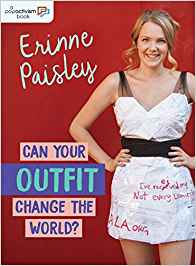| ________________
CM . . . . Volume XXIV Number 18. . . . January 12, 2017
excerpt:
Can Your Outfit Change the World? is the second entry in the “PopActivism” series, written by activist, public speaker, and University of Toronto student, Erinne Paisley. The clothing we choose to wear tells a story, and Paisley garnered a lot of social media attention in 2015 for the dress she wore to her prom. Her handcrafted ensemble was created out of old math homework, inscribed with the message, “I’ve received my education. Not every woman has that right. Malala.org.” She donated the money she would have spent on a formal gown to the Malala Foundation. With a friendly, conversational tone, this smartly written book examines the environmental, social, and personal costs to our purchases. The clothing manufacturing process and the environmental impact of materials (“something that either grows in a field or is made in a lab”) are explored. Lots of eye opening examples are included that will make you want to shop in a more globally conscious manner and not take for granted a seemingly simple cotton T shirt: “It typically takes 2,720 litres of water to create a single T shirt, which is the amount of water most people drink over three years! Cotton is also the most heavily pesticide sprayed crop in the world.” The push for fast fashion and the consumer drive to make trendy clothing as cheaply and quickly as possible take a huge toll on human beings, and the deplorable working conditions in garment factories in developing countries are detailed. The next chapters offer suggestions on how to become a savvy shopper and effectively “see change, share change, be change.” Paisley highlights ethical clothing stores and brands and promotes global movements such as Fashion Revolution (#fashrev) that asks companies to reveal the true story of where their clothing comes from and how their products are made (#whomademyclothes). The joys and greater purposes of second hand shopping (“Reduce, Reuse, and Recycle”) are also covered. Final chapters deconstruct and call into question fashion advertising images and gender expectations. As in the previous entry in the “PopActivism” series, Can Your Smartphone Change the World?, the information is presented in an engaging, interactive manner. Sidebars include practical tips and suggestions, like “Apps that help you buy less”, and “Do you need a bag for that?”. Pop quizzes, presented in the shape of a T shirt, are scattered throughout, offering up conversation starters and ideas: “How can you help create more media and advertising that shows diversity?”, “Boycott companies that are running campaigns with inaccurate or negative messages”, and “Email your favourite store and tell the staff what type of products you’d like them to sell”. The pages are also enlivened by notable quotes from Oscar Wilde (“Be yourself, everyone else is taken.”), Vivienne Westwood (“Buy less, choose well, make it last.”), and Jane Goodall (“You cannot get through a single day without having an impact on the world around you. What you do makes a difference, and you have to decide what kind of difference you want to make”). A glossary and a list of online resources are included at the end. Fashionistas will be inspired and emboldened by this nonfiction book that is bursting at the seams with thought provoking information. Highly Recommended. Linda Ludke is a librarian in London, ON and a vintage fashion enthusiast.
Next Review |
Table of Contents for This Issue
- January 12, 2018. |
